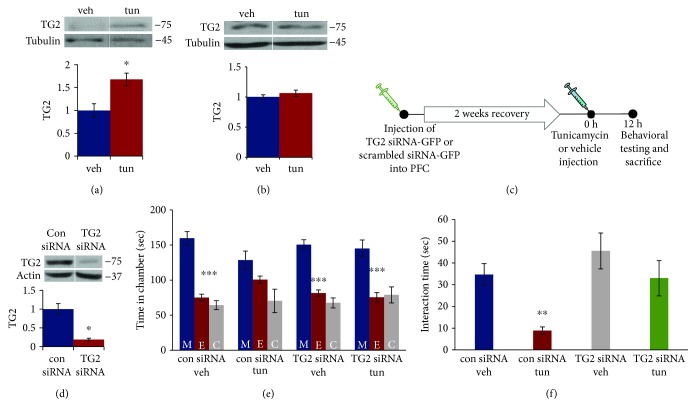Figure 1.
TG2 in the PFC mediates ER stress-induced deficits in social behavior in male mice. Tunicamycin treatment induced increase of TG2 protein levels in the mouse PFC. TG2 protein levels were determined in the mouse (a) prefrontal cortex (PFC) and (b) hippocampus 12 h after tunicamycin injection. Top: representative blot. Bottom: quantification of TG2 normalized to tubulin. Protein levels were measured by western blot analysis. ∗p < 0.05; Student's t-test. N = 3 (vehicle) and 5 (tunicamycin). (c) Schematic representation of stereotaxic injection of control or TG2 siRNA lentiviral particles into the mouse PFC followed by tunicamycin treatment for 12 h. (d) Decrease in TG2 expression in the PFC of mice injected with TG2 siRNA particles. Top: representative blot. Bottom: quantification of TG2 normalized to actin. Protein levels were measured by western blot analysis. ∗p < 0.05; Student's t-test. N = 4 (control siRNA) and 3 (TG2 siRNA). (e–f) TG2 siRNA administration attenuated tunicamycin-induced deficits in social behavior. (e) The three-chamber social interaction test. ∗∗∗p < 0.001 (E vs. M); two-way ANOVA. (f) Reciprocal social interaction test. ∗∗p < 0.01 vs. con siRNA-vehicle group; two-way ANOVA. (e–f) N = 7 (con siRNA veh), 7 (con siRNA tun), 7 (TG2 siRNA veh), and 6 (TG2 siRNA tun). Data are expressed as mean ± SEM. M: chamber housing stranger mouse; E: chamber housing an empty cage; C: center.

